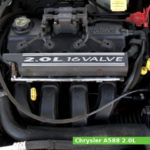
Cylinder bore and piston stroke are 87.5 mm (3.44 in) and 83.0 mm (3.27 in), respectively. The compression ratio rating is 9.8:1.
The Chrysler A588 engine produced 133.0 PS (98 kW; 132.0 HP) at 5,600 rpm of maximum output power and 175 N·m (17.8 kg·m, 129 ft·lb) at 4,600 rpm of peak torque.
The Chrysler A588 features:
- Single overhead camshaft (SOHC)
- 4 valves per cylinder (16 valves in total)
- Distributorless Direct Ignition System (DIS)
- Multi-Port Electronic Fuel Injection system
- Cast-iron cylinder block
- Aluminium cylinder head
General information
| Engine Specifications | |
| Engine model | A588 |
| Engine type | 4-stroke, SOHC, four-cylinder |
| Displacement | 2.0L, 1,998 cm3, (121.93 cu·in) |
| Max. horsepower | 133.0 PS (98 kW; 132.0 HP) at 5,600 rpm |
| Max. torque | 175 N·m (17.8 kg·m, 129 ft·lb) at 4,600 rpm |
| Cooling system | Forced air |
| Lubricating system | Forced lubrication |
| Ignition system | Distributorless Direct Ignition System (DIS) |
| Fuel system | Multi-Port Electronic Fuel Injection system |
| Firing order: | 1-3-4-2 |
| Dimensions (L x W X H) | – |
| Dry weight | – |
Cylinder Block and Head
| Cylinder block | |
| Cylinder block alloy: | Cast-iron |
| Compression ratio: | 9.8:1 |
| Cylinder bore: | 87.5 mm (3.44 in) |
| Piston stroke: | 83.0 mm (3.27 in) |
| Cylinder internal diameter (standard): | 87.4924-87.5076 mm (3.4446-3.4452 in) |
| Piston skirt outer diameter (standard): | 87.4630-87.4810 mm (3.4434-3.4441 in) |
| Number of piston rings (compression / oil): | 2/1 |
| Connecting rod small end diameter (standard): | 20.960-20.980 mm (0.8252-0.826 in) |
| Connecting rod center distance: | 50.9910-51.0050 mm (2.0075-2.0081 in) |
| Piston pin diameter: | 21.000-21.003 mm (0.8268-0.8269 in) |
| Side clearance (Top): | 0.025-0.065 mm (0.001-0.0026 in) |
| Side clearance (Second): | 0.025-0.065 mm (0.001-0.0026 in) |
| Ring end gap (Top): | 0.230-0.520 mm (0.0091-0.0205 in) |
| Ring end gap (Second): | 0.490-0.780 mm (0.0193-0.0307 in) |
| Ring end gap (Oil): | 0.230-0.660 mm (0.0091-0.026 in) |
| Ring width (Top): | 1.170-1.180 mm (0.0461-0.0465 in) |
| Ring width (Second): | 1.170-1.108 mm (0.0461-0.0436 in) |
| Ring width (Oil): | 2.854-3.008 mm (0.1124-0.1184 in) |
| Number of main bearings: | 5 |
| Crankshaft main journal diameter: | 51.9924-52.0076 mm (2.0469-2.0475 in) |
| Crankpin journal diameter: | 47.9924-48.0076 mm (1.8895-1.8901 in) |
| Crankshaft center distance: | 41.5 mm (1.635 in) |
| Cylinder head | |
| Cylinder head alloy: | Aluminium |
| Valve arrangement: | SOHC, belt driven |
| Valves: | 4 (16 valves in total) |
| Intake timig: | 207° |
| Exhaust timig: | 229° |
| Valve head diameter (INTAKE): | 32.120-33.370 mm (1.2646-1.3138 in) |
| Valve head diameter (EXHAUST): | 28.570-28.830 mm (1.1248-1.135 in) |
| Valve length (INTAKE): | 114.690-115.190 mm (4.5153-4.535 in) |
| Valve length (EXHAUST): | 116.940-117.440 mm (4.6039-4.6236 in) |
| Valve steam diameter (INTAKE): | 5.934-5.952 mm (0.2336-0.2343 in) |
| Valve steam diameter (EXHAUST): | 5.906-5.924 mm (0.2325-0.2332 in) |
| Valve spring free length (INTAKE): | 46.75 mm (1.8405 in) |
| Valve spring free length (EXHAUST): | 46.75 mm (1.8405 in) |
Service Data
| Compression pressure | |
| Standard: | 15.5 bar (15.8 kg/cm2; 225 psi) |
| Minimum: | 11.0 bar (11.2 kg/cm2; 160 psi) |
| Oil system | |
| Lubrication system: | Forced lubrication |
| Recommended oil: | SAE 10W-30 |
| Oil capacity: | 4.3 L (4.54 US. qt, 3.78 Imp. qt.) |
| Oil pressure: | 25 kPa (3.6 psi) at Idle speed 170 kPa (24.7 psi) at 3,000 rpm |
| Ignition system | |
| Type: | Distributorless Direct Ignition System (DIS) |
| Spark plug: | Champion RC12YC |
| Spark plug gap: | 1.2-1.3 mm (0.047-0.051 in) |
| Spark plug torque: | 28 N·m (2.9 kg·m, 20.6 ft·lb) |
Applications
| Model | Years Produced |
| Dodge Neon | 1995–2005 |
| Plymouth Neon | 1995–2005 |
| Dodge Stratus | 1995–2000 |
| Plymouth Breeze | 1995–2000 |
 Author:
Author: